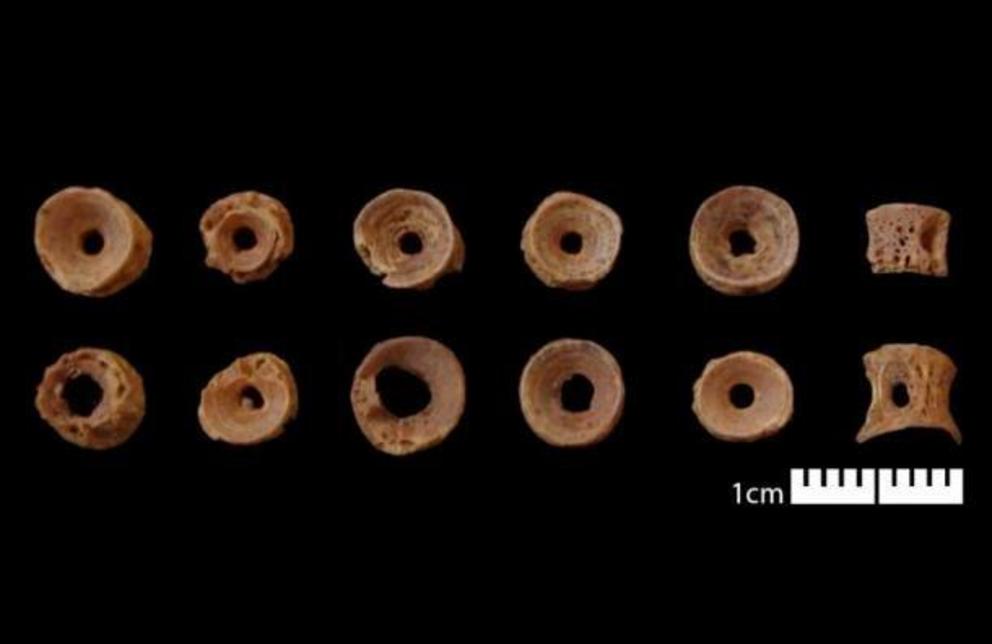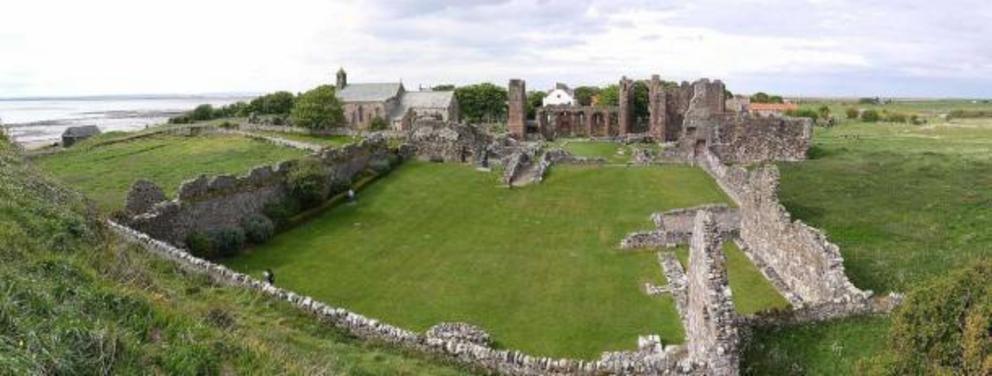Diggers find England’s oldest prayer beads on Lindisfarne Holy Island!
Top image: Lindisfarne Castle on the Holy Island of Lindisfarne is currently part of crowdfunded archaeological digs through DigVentures, and their most recent find were prayer beads made from salmon vertebrae.
Archaeologists exploring Lindisfarne, an island known for its rich religious history - including the first Viking invasion - have recovered the oldest prayer beads ever found in England.
While digging in an ancient burial site on the island of Lindisfarne off the coast of Northumberland in northeast England, a team of experts under the guidance of Dr. David Petts from the University of Durham were delighted to discover a necklace of prayer beads that had been placed inside one man’s grave. According to Digventures, who collaborate and fundraise for the ongoing investigation at Lindisfarne, the beads were made from the vertebrae of salmon, and after careful analysis the archaeologists were able to date the beads to the eighth or ninth century AD.
This is the first time any type of artifact has been found inside a burial on Lindisfarne. Nevertheless, finding an item connected to Christian worshipping practices on the island is not surprising. Lindisfarne has long been known as the “Holy Island,” in recognition of its storied history as a haven and sanctuary for practitioners of the Christian faith. That history extends all the way back to the seventh century, when England was still an enclave for Anglo-Saxon culture, society, and religion.
 These are the oldest prayer beads ever found in England, which were recently unearthed on the Holy Island of Lindisfarne as part of an ongoing crowdfunded archaeological project.
These are the oldest prayer beads ever found in England, which were recently unearthed on the Holy Island of Lindisfarne as part of an ongoing crowdfunded archaeological project.
The 1,200-year-old Sacred Fish Prayer Beads of Lindisfarne
It is known that the medieval Lindisfarne monastery once stood near the site where the prayer beads were unearthed. Consequently, the archaeologists believe the grave where the beads were found would have been the final resting place of a monk who had lived there more than 1,200 years ago.
If the burial site was that of a monk, he may have been among the group of monks who composed, illuminated and published the renowned Lindisfarne Gospels , which are considered the pre-eminent surviving religious text from England’s Anglo-Saxon England. He could have even been the monk identified as the primary author of the Gospels, Eadfrith, who is said to have completed work on the book around the year 700.
Whoever the monk was, he would have used the prayer beads for private devotions and worship.
“We think of the grand ceremonial side of early medieval life in the monasteries and great works like the Lindisfarne Gospels,” Dr. Petts, who specializes in the study of early Christianity, told the Telegraph . “But what we’ve got here is something which talks to a much more personal side of early Christianity.”
The use of salmon vertebrae to make the beads is notable, because of how it dovetails with the incorporation of fish symbolism in Christian practice. Fish were an early emblem of Christianity, and the association of fish with the worship of Jesus can be traced all the way back to the first century AD.
The Greek word for fish is “ichthys,” and early worshippers of the church made an acrostic from this word that represents the central figure of their religion: Iesous Christos Theou Yios Soter (ICHTHYS), or “Jesus Christ, Son of God, Savior.” Fish are also associated with Christ’s miraculous feeding of the 5,000 with just two fish and five loaves of bread, and Christ is also known to have referred to his disciples as “fishers of men.”
 The Lindisfarne Priory viewed from above.
The Lindisfarne Priory viewed from above.
The Story of Lindisfarne, the Holy Island
The Holy Island of Lindisfarne is located in the North Sea just a few miles south of the southeastern border of Scotland and England. It is secluded but not remote, as it is connected to Northumberland by a causeway that is sometimes open and sometimes covered with water, depending on the movement of the tides.
Lindisfarne first became a religious center during the seventh century. Acting on what would seem to have been a whim, King Oswald of Northumbria dispatched St. Aidan, an Irish monk serving the church in Iona in Scotland, to Lindisfarne. His job was to convert this remote and peaceful oasis into a spiritual mecca for Anglo-Saxon Christians. To facilitate the conversion St. Aidan founded the Lindisfarne Monastery in 635, and then stayed on to serve as its first abbot and bishop.
The monks who wrote the famous Lindisfarne Gospels were affiliated with this monastery.
This acclaimed masterpiece includes a copy of the Four Gospels, which recount the life of Christ, plus several related texts that include chapter lists and a letter written by St. Jerome to Pope Damasus, after the latter had commissioned St. Jerome to translate the Bible into Latin in the fourth century. The book is separated into different sections by five elaborately and elegantly designed carpet pages, which were apparently modeled after luxurious carpets imported from the eastern Mediterranean. It includes illustrations of religious figures in a few sections as well, which are quite impressively rendered.
In the late eighth century, Lindisfarne earned the distinction of becoming the first British territory to be raided by the Vikings . The Vikings returned to the island several times after that, and by 875 the last of the Anglo-Saxon monks had left Lindisfarne to return to the mainland.
Sometime after the Norman Conquest of England in the 11th century the monks returned to build a new monastery. This institution was active and occupied until 1537, when Henry VIII decreed that all English monasteries be dissolved .
It is the ruins of the old monastery, however, that have most interested archaeologists during their recent excavations.
 The excavation project that produced the remarkable salmon vertebrae prayer beads find has a unique history. It was not sponsored by an academic institution but has instead been funded entirely by donations obtained through the crowdsourcing platform DigV
The excavation project that produced the remarkable salmon vertebrae prayer beads find has a unique history. It was not sponsored by an academic institution but has instead been funded entirely by donations obtained through the crowdsourcing platform DigV
DigVentures: Making Crowd-Funded Archaeology Pay Off!
Dr. Petts noted that the ancient prayer beads were almost overlooked. At first it was assumed they were simply normal necklace decorations, and that they were made from fish bones because that material was common and widely available on the island.
But Marina Chorro Giner, a zooarchaeologist assigned to the excavation project, noticed something significant.
“This bright, eagle-eyed researcher looked at them and said, actually these aren’t just fish bones , they’ve been modified and turned into something,” Dr. Petts explained.
After a closer examination it became clear that the bones had been polished and shaped into prayer beads, and once their antiquity was established the archaeologists realized that no one had ever found prayer beads this old in England before.
The excavation project that produced this remarkable find has a unique history. It was not sponsored by an academic institution, but has instead been funded entirely by donations obtained through the crowdsourcing platform Dig Ventures .
The aim of the project is to discover more about ancient Anglo-Saxon society and its cultural and religious practices, and the project will continue for as long as members of the public are willing to fund it.

